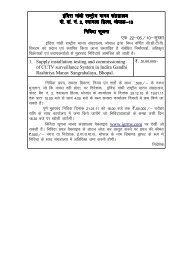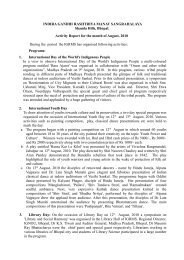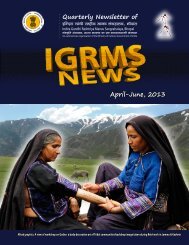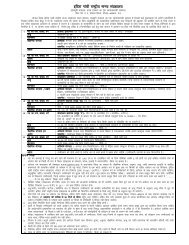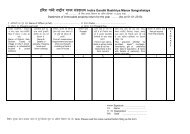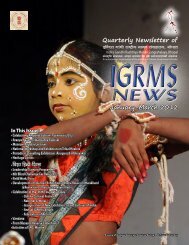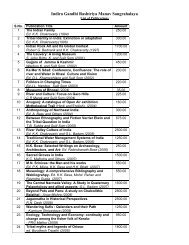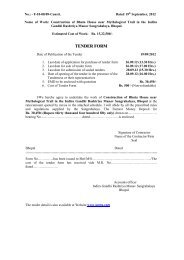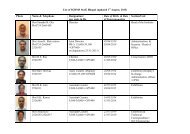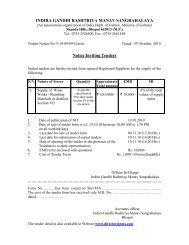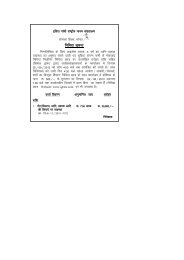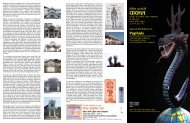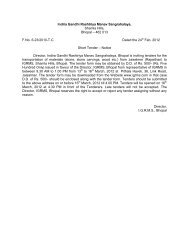Indira Gandhi Rashtriya Manav Sangrahalaya (National ... - IGRMS
Indira Gandhi Rashtriya Manav Sangrahalaya (National ... - IGRMS
Indira Gandhi Rashtriya Manav Sangrahalaya (National ... - IGRMS
You also want an ePaper? Increase the reach of your titles
YUMPU automatically turns print PDFs into web optimized ePapers that Google loves.
284 Multiple Heritage: Role of Specialised Museums in India<br />
The <strong>IGRMS</strong> has been emphasizing on collection and documentation of tradition<br />
based technologies from different parts of the country. Based on the field experience<br />
to different remote villages in India, a new open air exhibition titled Tradtional<br />
Technology was developed and opened for visitors in March, 2008. This exhibition<br />
presents the knowledge or wisdom practised by indigenous communities in the<br />
utilization of locally available resources to fulfil their sustained way of living. Some<br />
of the note-worthy exhibits, in this open air exhibition, are Meitei Thim Shungba<br />
(traditional salt making technology of Manipur), Gangugu (traditional oil expelling<br />
technology of Andhra Pradesh), Ganna Charkhi (traditional technology of sugarcane<br />
juice extraction process practised in Chhattisgarh), Tirahi (typical oil expelling<br />
technology), Gharat, Tui-Changshu, Edullumota (traditional water management systems<br />
adopted in Uttaranchal, Manipur, and Andhra Pradesh respectively) etc.<br />
Veethi Sankul-Indoor Museum was constructed in about twelve thousand<br />
sqm. area with spacious exhibition halls, a reference library, indoor & outdoor<br />
auditoriums and other miscellaneous facilities, and dedicated to the nation in<br />
March, 2005. The structure is unique in its architecture, constructed on a rocky<br />
terrain incorporating difficult levels of the sloppy land. The various exhibition<br />
halls and auditoriums have been constructed on approximately 16 levels. The<br />
structure is covered with Dholpur sand-stone, and the flooring is made with<br />
Kota stones. Approximately 7000 sq.mt. floor area is utilized for exhibitions, in<br />
10 galleries. These are named as:<br />
Gallery 1 : Human Evolution and Variation: Presenting the landmarks of process<br />
of human evolution in different stages through models, photographs,<br />
charts, sketches etc. Emphasis has been put on the Narmada-man<br />
discovered at Hathnora in Madhya Pradesh which indicates India as<br />
one of the theatres of human bio-cultural evolution;<br />
Gallery 2 : Human Odyssey–Depicting material cultural objects on settlement<br />
patterns, subsistence and aesthetic activities of hunter-gatherers,<br />
shifting cultivators, pastoralists, peasants and ethno-medicine<br />
practitioners in India;<br />
Gallery 3 : Longo Jatra–A festival of the Koitor life style and festivities of Gond<br />
tribes of Central India;<br />
Gallery 4 : Mandwa Gohri – envisages holistic presentation on the Bhil tribes of<br />
Western India;<br />
Gallery 5 : Ethnic Art:–Presents the ethnic art of selected folk and tribal<br />
communities from Andhra Pradesh, Madhya Pradesh, Rajasthan etc.;<br />
Gallery 6 : Belief Systems, Cosmology and Rituals–Presents ritual objects,<br />
photographs, masks, memorial pillars, paintings etc. to narrate<br />
cosmology, belief systems and rituals of different communities;<br />
Gallery 7 : Music & Performing Traditions–presents music traditions of various<br />
communities.



